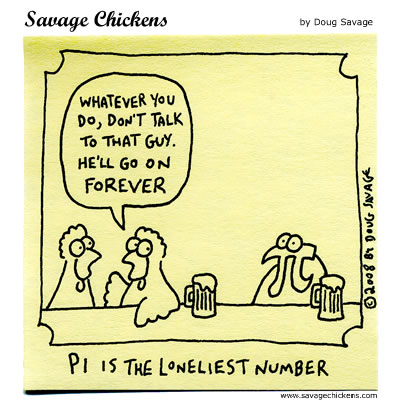Did you know that the earliest documented use of an approximation of pi was by the Egyptians and Babylonians about 4,000 years ago? The first rigorous calculation didn’t happen until around 250 BC, when Archimedes used the method of exhaustion to approximate pi as 3.14185.
For anyone who is not familiar with the method of exhaustion (and really, you shouldn't be), it can be used to calculate the circumference of a circle by drawing two polygons, one on the outside of the circle and one on the inside. As the number of sides of the polygons increases, the area of the polygon gets closer to the circumference of the circle, as illustrate d in the picture below. In his calculation, Archimedes used a 96 sided polygon! I’m exhausted just thinking about it…
For anyone who is not familiar with the method of exhaustion (and really, you shouldn't be), it can be used to calculate the circumference of a circle by drawing two polygons, one on the outside of the circle and one on the inside. As the number of sides of the polygons increases, the area of the polygon gets closer to the circumference of the circle, as illustrate d in the picture below. In his calculation, Archimedes used a 96 sided polygon! I’m exhausted just thinking about it…
Image credit: Methods of Exhauation Wikipedia Page
To solve equations for my math and science classes, I always used 3.14 to approximate pi. But how close does this get you to the correct answer? Believe it or not, for most applications, 3.14 is a good enough estimate. However, if you wanted to use pi to calculate an extremely large circumference, such as one that fits the universe, 3.14 would not get you a very accurate answer. In fact, to calculate a circle of that size within the distance of a single atom, you still would not need to use more than 39 decimal places of pi. But that hasn’t stop mathematicians from competing to have the world record for most digits of pi calculated. Fabrice Bellard is a computer scientist who has recently claimed that he may hold the new record, having calculated pi to 2.7 trillion digits!
Here are a few fun facts about Pi and Pi Day:
- Pi Day was first celebrated in 1988 at the Exploratorium in San Francisco
- Pi Day also happens to be Albert Einstein’s birthday
- Pi is not limited to circles, but also used in equations for statistics, physics and economics
- A billion decimals of pi printed in standard font would stretch from New York City to Kansas.
- On Star Trek they rid the Enterprise’s computer of an evil entity by sending the computer into an infinite loop by ordering the computer to "compute to the last digit the value of pi."



Hey Sarah - great Pi Day post! We have celebrated Pi with a musical collection of Pi reference songs. Would love for you to stop by and check us out: www.educationalrap.com
ReplyDeletePS - Love the cartoon!
Cheers,
Taunia / RRR / educationalrap.com